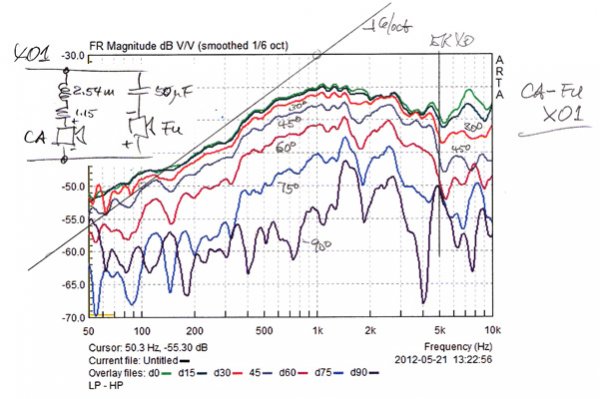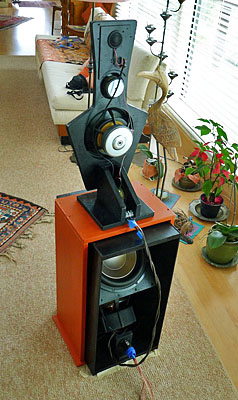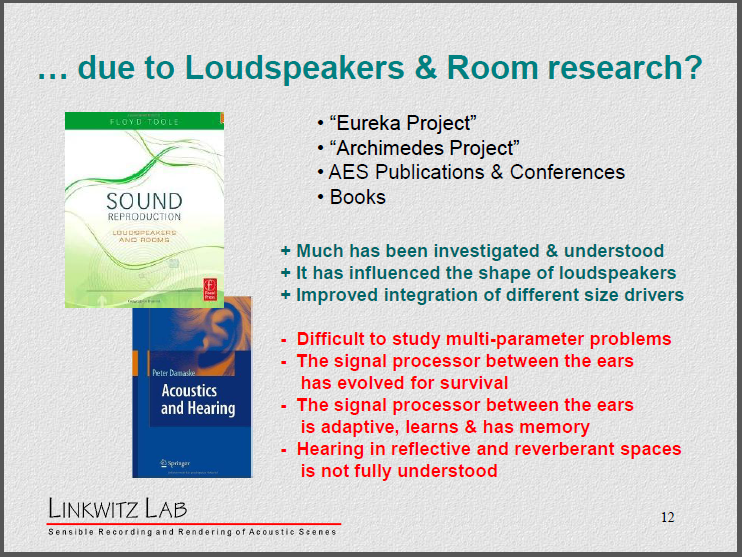Thank you Myles. That is a good read and nice format to let each industry person speak their point of view on the relevance of measurements. Out of all of those though, I only counted two people who commented on loudspeaker measurements. For now, let me discuss one of them whose work I know,Siegfried Linkwitz, from his AES paper, Room Reflections Misunderstood? It is a great easy to read paper that I hope membership seeks out and reads. Let's see what he says in your article first:
"Siegfried Linkwitz, VP, R&D,
Audio Artistry
I would have to say that measurement of
the speaker's frequency response is the
technical measurement that comes closest
to predicting the sound of a loudspeaker. If
you see a graph of a 20 to 20,000 kHz ±2 dB
on-axis, anechoic response you can be fairly
sure that the speaker has a smooth
sound characteristic.
However, this information
alone does not necessarily imply
that the sound is neutral. transparent and
dynamic, and that it would dis play those
characteristics in your room.
First of all, it takes more than the anechoic
on-axis response to describe t he
sound you hear. When you listen in a room,
your ears not only receive the on-axis sound
but also, with a slight delay, the sound that
has bounced around in your room and been
modified by it. Thus, the anechoic response
must also be measured at angles up to at
least ±60 degrees horizontally and ± 15
degrees vertically off-axis, in order to assess
the contribution of sound radiation in these
directions to the overall sound, when the
speaker is placed in a room.
Simply averaging the different anechoic responses over a
"listening window" or normalizing them to
the on-axis response is not as relevant a
description as is plotting the actual frequency
response curves at different angles on the
same graph.
The other half of the equation, which is
also related to a speaker's frequency
response. is its phase response.
[...]
However. I am not
convinced that the typical amounts of
phase shift due to crossovers that are
observed in these higher frequency regions
have audible effects. On the other hand, I
am convinced that phase shift is very
important at the low frequency end of the
spectrum."
You can read the rest of his write up in the article but it doesn't change the summary of it exposed above. That is, he is 100% in agreement with Dr. Toole's research that it is both on-axis and off-axis frequency response measurements that are great predictors of loudspeaker sound. As I mentioned, the research/Harman's measurements are for the entire hemisphere around the loudspeaker, and predictions are made by weighted combination of each class of reflections. Sound bouncing from behind the loudspeaker for example, has less impact on its sound than on-axis. Or first side reflection. I have also left the part about phase in there which above bass frequencies, it is not an audible concern (agrees with research from Vanderkooy).
For confirmation of how well he is aligned with Dr. Toole's research, let's look at what he says in the AES paper I referenced earlier:
"Furthermore,
it had been found that loudspeakers with wide
horizontal dispersion were preferred in listening tests
[4]. What is known scientifically about loudspeakers
and rooms for sound reproduction has been reviewed
by F. E. Toole [11]."
Notice how he completely differs to work of Dr. Toole with nary of an objection. The reference is: "[11] Floyd E. Toole, “Loudspeakers and Rooms for Sound Reproduction – A Scientific Review”, J. Audio Eng. Soc., vol. 54, pp. 451-476 (2006 June)"
Here is another point of agreement:
"For example, the
author and others had observed that wide horizontal
dispersion in the high frequency range of a
loudspeaker is subjectively desirable and increases
fidelity [4]."
And the reference: "[4] F. E. Toole, “Loudspeaker Measurements and Their Relationship to Listener Preferences”, J. Audio Eng. Soc., vol. 34, part 1, pp. 227-235 (1986 April); part 2, pp. 323-348 (1986 May)"
As I said, while this research may seem new to members here, it is accepted as foundation of acoustic and sound reproduction science by many researchers and designers. So it is no wonder that a reference that you pick Myles as a counterpoint to mine, happens to be completely supportive of the research I have been sharing. Yes, Linkwitz says he listens to loudspeakers too to find problems . Nothing different has been said. We still listen. But measurements of loudspeakers when made according to a system that takes into account how it acts in a room and our perception, is a strong predictor of our preferences.











